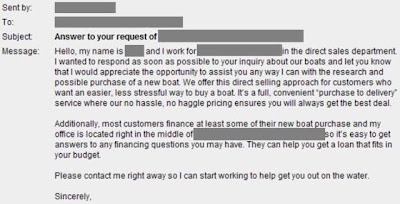
Last week I presented to dozens of boat dealers currently facing an unprecedented combination of economic challenges. I was encouraged by the fact that they were not just looking for practical solutions to maintain their businesses, but to grow while their competitors cower in fear.
This morning I was editing my post about stealing share in a down market when I received an article that perfectly captured my same message. This article more succinctly conveyed my point so I have allowed Roy H. Williams to become my guest blogger today (I hope he doesn’t mind). I would encourage you to subscribe to The MONDAYMORNINGMEMO.com.
* * * * * * * * * * * * * * * *
What to expect in 2009 - December 8, 2008
Ready to play leapfrog?
By Roy H. Williams
The MONDAYMORNINGMEMO.com
The coming year will be fun, adventure-filled and profitable for people who have their wits about them.
A number of small business owners are positioning themselves to overtake their much larger rivals.
Will one of these companies be yours?
Not many years ago, General Motors and Circuit City were the dominant players in their categories. Today they’re both on their knees, having made the same mistakes:
1. They took their fingers off the pulse of the customer.
When you believe your marketing pipeline will allow you to dictate what the customer will buy, you’re in danger of being leapfrogged. In 1960, General Motors sold nearly 60 percent of all new cars. Today, even though Chevrolet maintains 4,200 dealerships, Toyota sells more cars than all 5 GM brands combined through just 1,400 locations.
LESSON: Having the right product is more important than heritage and convenience.
2. They quit taking risks.
When companies achieve success, they usually quit innovating and become guardians of the status quo. But yesterday’s perfect processes are obsolete tomorrow. Vinyl records were replaced by 8-track tapes. 8-tracks were replaced by cassettes. Cassettes were replaced by CDs. And now CD’s are being replaced by MP3 players. The same is happening with business practices.
LESSON: Success, like failure, is a temporary condition. Never assume you've arrived.
The leaders are going into hunker-down mode. They’re cutting back their advertising, assuming that everyone else will cut back as well.
When a leapfrogger sees a leader’s brake lights, he hits the accelerator. Are you beginning to see what I meant when I said, “fun, adventure-filled and profitable?”
Here are the trends to watch in 2009:
1. Frivolous purchases are being delayed.
We’re wearing our clothes longer and keeping the cars we’ve got. We'll buy what we need, but only after asking whether we really need it.
2. We're buying fewer things, but better things.
More attention is being paid to quality. Only the poorest are choosing by price alone. Information is king. Details are power. This is good news for makers of better products.
3. “Sustainable” is a concept that will grow in power for at least 10 years.
The lifestyle of the 80's and 90's was "upwardly mobile" and its leaders were marked by "conspicuous consumption." But the chosen lifestyle of the next generation will be "sustainable," meaning that we'll strive to live within our means and embrace practices that are environmentally responsible.
Want to be a leapfrogger?
Roy H. Williams
* * * * * * * * * * * * * * * *
Next week I’ll be discussing a strategic marketing approach I have employed to profitably grow sales and market share while reducing marketing budgets; you won’t want to miss it.
Pro Lead Management clients have realized exponential sales and market share growth with even greater returns on investment. Find out what we can do for you; call 888.836.8567 or contact us by clicking here for a FREE consultation.

















